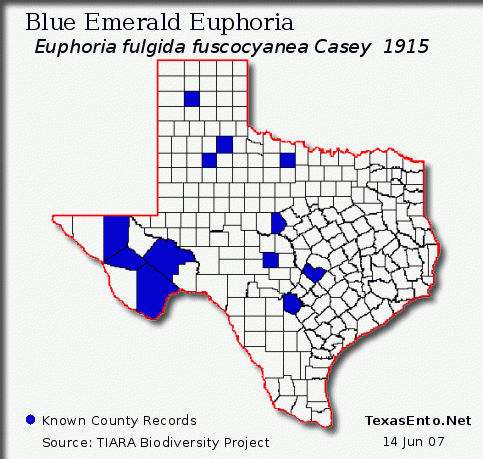|
|
Return to Texas Entomology - Compiled by Mike Quinn
|
|
along the roadside of the Chisos Basin access road,
roughly the lower-middle part of Green Gulch
|
|

|
Data per TIARA Biodiversity Project
Range:
Full species is wide spread but rather uncommon east of the Rocky Mountains, also occurs in Arizona, New Mexico, and Canada (Hayes, 1925).
Flight Period: March to August in Texas per 50 specimens in TAMUIC
Food:
Adults feed on sap exuding from wounds of trees or frequenting plants such as thistles (Hayes, 1925).
Larvae reared on manure (Hayes, 1925).
Similar Species: There are approximately 73 species of Euphoria and about 20 species in the U.S. per Arnett et al. (2002).
Texas Taxa: (per Orozco, 2012)
Euphoria biguttata (Gory and Percheron)
Euphoria casselberryi Robinson - Type locality: Davis Mountains, Jeff Davis Co. (Robinson, 1937).
Euphoria devulsa Horn
Euphoria discicollis (Thomson)
Euphoria fulgida (Fabricius) (= Euphoria fulgida fuscocyanea Casey)
Euphoria herbacea (Olivier)
Euphoria hirtipes Horn
Euphoria inda (Linnaeus)
Euphoria kernii Haldeman
Euphoria schotti LeConte - Type locality is Eagle Pass, Maverick County. (LeConte, 1853).
Euphoria sepulcralis (Fabricius)
Photos: Adult - Adult - Ventral - Ventral - BugGuide.Net
Etymology:
Euphoria fulgida fuscocyanea Casey 1915
Euphoria fulgida fulgida (Fabricius, 1775)
eu (G). Good, well
phor, -a, -e, -i, -o (G). Carry, bearfulg, -en, -i (L). Flash, gleam
-id (L). A condition offusc (L). Dusky, brown
cyan, -e, -i, -o (G). Dark blue
Biography:
Thomas Lincoln Casey (1857 - 1925) - University of Nebraska
Johan Christian Fabricius (1745 - 1808) - University of Nebraska
References:
Arnett, R.H., Jr., M.C. Thomas, P. E. Skelley & J.H. Frank. (editors). 2002. American Beetles, Volume II: Polyphaga: Scarabaeoidea through Curculionoidea. CRC Press. 861 pp.
Borror, D.J. 1960. Dictionary of Word Roots and Combining Forms. National Press Books, Palo Alto. v + 134 pp.
Blatchley, W.S. 1910. The Coleoptera of Indiana. Bulletin of the Indiana Department of Geology and Natural Resources 1: 1-1386.
Casey, T. L. 1915. A review of the American species of Rutelinae, Dynastinae, and Cetoniinae. Memoires of the Coleoptera 6: 1-394.
Hayes, W.P. 1925. A comparative study of the life cycle of certain phytophagous scarabaeid beetles. Kansas Agricultural Experimental Station Technical Bulletin, 16:1-146.
Orozco, J. 2012. Monographic revision of the American genus Euphoria Burmeister, 1842 (Coleoptera: Scarabaeidae: Cetoniinae). The Coleopterists Society Monographs 11: 1-182.
Ratcliffe B.C. 1991. The scarab beetles of Nebraska. Bulletin of the University of Nebraska State Museum. 12: 1–333.
Riley, E.G. & C.S. Wolfe. 2003. An annotated checklist of the Scarabaeoidea of Texas. Southwestern Entomologist, Supplement, no. 26. 37 pp.
Ritcher, P.O. 1945. North American Cetoniinae with descriptions of their larvae and keys to genera and species (Coleoptera: Scarabaeidae). Kentucky Agriculture Experiment Station Bulletin 476: 1-39 pp.
Ritcher, P.O. 1966. White Grubs and Their Allies, a Study of North American Scarabaeoid Larvae. Oregon State University Monograph Series No. 4: 1-219.
White, R.E. 1983. A Field Guide to the Beetles of North America. Houghton Mifflin Company, Boston. xii + 405 pp.
22 Jan 2013 © Mike Quinn / Texas Entomology / Texas Beetle Pages